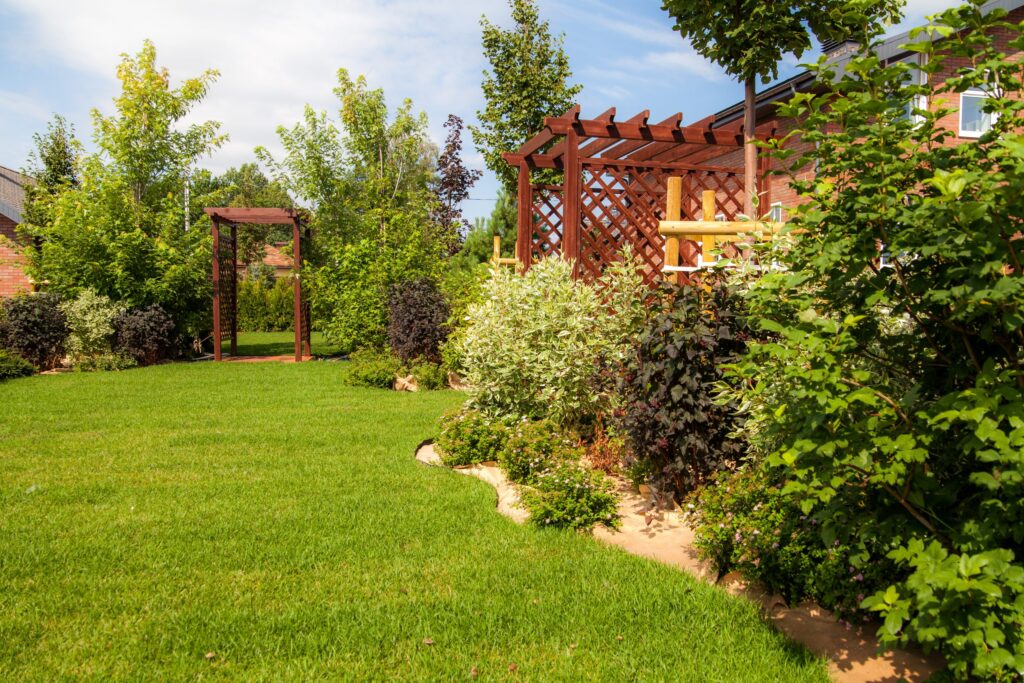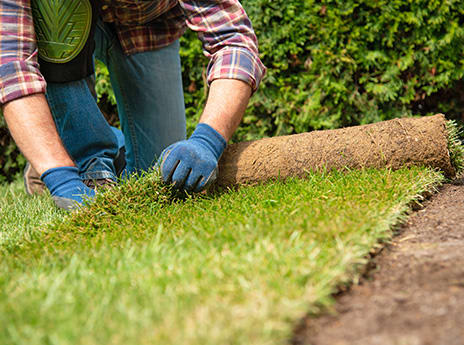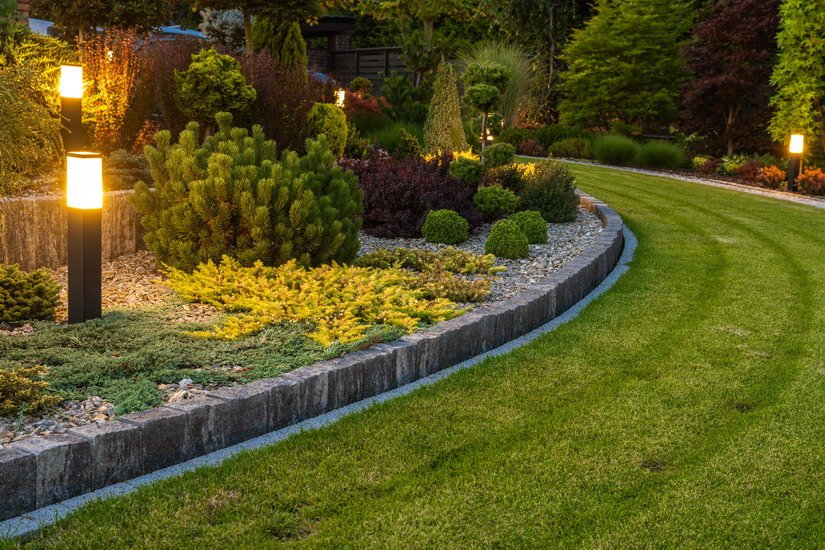Recognizing the Comprehensive Scope of Functions in Professional Landscape Design Services
The comprehensive extent of specialist landscaping services incorporates a variety of essential aspects - landscaping. It consists of landscape style principles, plant selection, and hardscaping features. In addition, it resolves irrigation systems and upkeep techniques. Each element plays a vital duty in developing useful and visually pleasing exterior areas. Understanding exactly how these parts work with each other can reveal much concerning the art and science of landscape design. Nevertheless, the journey into this complex area is just starting
Landscape Design Concepts
Reliable landscape design concepts are important for developing harmonious exterior spaces that improve both aesthetic charm and functionality (Learn More). These principles assist the arrangement of components within the landscape, making sure a natural visual experience. Key components include balance, which disperses visual weight uniformly; proportion, which associates the dimension of different aspects to every other and the space; and unity, which produces a sense of integrity with constant styles and materials

Plant Choice and Installation
In the domain name of professional landscape design, plant selection and installation play an essential function in attaining a flourishing garden. Stressing native plant benefits, seasonal considerations, and the specific dirt and sunlight needs of each types assures a sustainable and aesthetically pleasing landscape. Cautious planning in these locations not only enhances biodiversity yet likewise advertises lasting ecological wellness.
Native Plant Advantages
Why should homeowners think about native plants for their landscape design jobs? Indigenous plants offer many advantages that boost both aesthetics and environmental sustainability. They are well-adapted to local environments, calling for less water and maintenance contrasted to non-native species. This strength minimizes the requirement for chemical plant foods and pesticides, advertising a much healthier ecosystem. In addition, native plants offer habitat and food for regional wild animals, consisting of pollinators, which can boost biodiversity in houses. Their familiarity with regional soil and climate conditions likewise brings about much better development prices and long life. By selecting indigenous plants, home owners not only produce aesthetically attractive landscapes however additionally add to ecological conservation, making a positive influence on their local environment. Indigenous plants stand for a clever option for landscape design projects.
Seasonal Plant Considerations
Home owners that have actually accepted native plants in their landscape design can additionally boost their exterior rooms by thinking about seasonal plant options. By integrating plants that prosper in details periods, they can produce visually attractive and dynamic landscapes throughout the year. Spring may introduce vivid blossoms like tulips and daffodils, while summer season can display lush foliage and vivid perennials. Fall introduces a palette of warm tones with asters and goldenrods, while winter season can be accentuated with evergreens and ornamental turfs for texture. Specialist landscaping companies typically recommend selecting plants that not just enhance existing native varieties yet likewise offer year-round interest and assistance regional wild animals. This thoughtful method to seasonal plant selection guarantees a consistently progressing and lasting yard atmosphere.
Soil and Sunshine Needs
Effective landscaping pivots on comprehending the particular dirt and sunlight demands of plants. Different species thrive under differing problems, needing a careful assessment of both factors throughout the selection procedure. Soil types, such as sandy, clay, or fertile, influence water drainage, nutrition schedule, and root growth. In addition, pH levels can impact plant health, requiring dirt testing to establish viability. Sunlight needs vary substantially; some plants grow completely sun, while others favor partial or full shade. An expert landscaper thinks about these components to assure peak growth and aesthetic allure. By aligning plant selections with the environment's certain features, landscapes can attain sustainability, resilience, and visual consistency, ultimately resulting in successful plant facility and lasting upkeep.
Hardscaping Features and Construction

While landscaping commonly stimulates photos of lush greenery and vivid flowers, hardscaping functions play an important duty in specifying outside spaces. These elements, which include patios, walkways, preserving wall surfaces, and ornamental stonework, supply structure and functionality to backyards and gardens. Hardscaping utilizes products such as concrete, rock, brick, and wood, permitting varied designs that complement the natural landscape.
The construction of hardscaping functions requires mindful preparation and implementation to assure durability and aesthetic appeal. Experts assess site conditions, water drainage, and spatial partnerships to develop natural exterior atmospheres. Proper installment techniques are critical, as they stop concerns like disintegration and changing with time.
Including hardscaping not just enhances the visual passion of a home yet also promotes outside activities, making it an essential aspect of comprehensive landscape design services. Inevitably, thoughtful hardscaping contributes to both the capability and appeal of outside spaces.
Watering Equipments and Water Administration
Reliable watering systems and water monitoring are important parts of expert landscaping, as they assure that plants get the essential hydration for perfect growth. These systems can differ from easy drip watering arrangements to advanced automated automatic sprinkler, created to satisfy the details demands of diverse landscapes. Proper water administration not only enhances water use, minimizing waste, but also enhances plant health and reduces illness threats.
Landscaping professionals examine various variables, consisting of dirt kind, plant types, and neighborhood environment, to develop tailored irrigation services. In addition, including rain harvesting strategies can better enhance sustainability and performance. Normal upkeep of watering systems is essential to preserve performance and stop leakages, more helpful hints which can cause water loss and raised expenses (Learn More). Ultimately, a properly designed irrigation system plays a crucial function in maintaining the visual charm of outside spaces while advertising ecological stewardship within specialist landscaping techniques
Lawn Care and Maintenance Techniques
Grass treatment and maintenance strategies are essential for accomplishing a lavish, healthy lawn that boosts the overall landscape. These approaches encompass different practices aimed at advertising ideal growth and visual allure. Normal mowing is vital, as it encourages thick, even development while preventing weeds from establishing. In addition, appropriate fertilization gives required nutrients, with applications customized to the particular lawn kind and soil conditions.
Watering methods need to concentrate on deep, occasional watering to encourage root growth, while oygenation improves soil structure and advertises nutrient absorption. Insect and condition administration is additionally crucial; determining problems early permits reliable treatments that reduce damages.
Overseeding can invigorate slim or damaged yards, improving density and shade (landscaping services). By executing these targeted grass treatment approaches, landscape design experts can ensure that lawns stay healthy and vibrant throughout the seasons, greatly adding to the overall beauty of the home
Seasonal Landscape Treatment and Upkeep
As the periods change, proper landscape care becomes important for preserving the health and wellness and charm of outdoor spaces. Each period offers special challenges and requirements. In spring, landscape professionals concentrate on trimming, planting, and feeding to urge development. Summer season needs normal watering, weed control, and bug management to protect recently established plants.

Throughout the year, seasonal landscape upkeep guarantees that exterior areas continue to be healthy and balanced and visually enticing. Expert services can offer customized upkeep plans that adjust to the certain needs of each season, enabling home proprietors to enjoy lively landscapes year-round. On the whole, seasonal care is an important facet of specialist landscape design that promotes durability and visual value.

Lasting Landscape Design Practices
An expanding number of property owners are welcoming sustainable landscape design practices to produce environmentally friendly outside areas. These methods concentrate on conserving resources, enhancing biodiversity, and reducing ecological influence. Indigenous plants are usually picked for their low tide needs and compatibility with regional communities, minimizing the demand for chemical plant foods and chemicals. Rainfall gardens and permeable paving are employed to manage stormwater runoff, advertising groundwater recharge and lowering disintegration.
In addition, lasting landscaping includes organic gardening techniques that focus on dirt health and wellness and promote natural insect control. Effective watering systems, such as drip watering and rain harvesting, aid enhance water use. In addition, landscape developers progressively promote for the use of recycled products, such as recovered wood and rocks, to lessen waste. By embracing these sustainable techniques, building owners not just add to environmental conservation yet additionally create aesthetically pleasing settings that can love marginal upkeep.
Regularly Asked Questions
How Long Does a Landscape Design Project Typically Take to Total?
Commonly, a landscape design job can take anywhere from a few days to a number of weeks to finish, relying on the job's size, intricacy, and layout demands. Variables such as climate and resource availability additionally affect timelines.
What Elements Influence the Expense of Landscape Design Services?
Various variables affect landscaping solution expenses, consisting of project size, style intricacy, worldly quality, labor expenses, geographical area, and seasonal demand. Each aspect adds distinctively to the overall economic needs of a landscape design task.
Are Landscaping Provider Available Year-Round?
Landscaping services are usually available year-round, although schedule may vary based on area, seasonal weather condition problems, and certain service offerings. Some services might be restricted throughout extreme weather or off-peak seasons.
Do Landscaping Firms Deal Guarantees on Their Job?
Several landscape design companies do provide guarantees on their job, which can differ in size and protection. Customers are motivated to ask regarding details terms, ensuring they understand what is assured and any type of problems that use.
Can I Design My Landscape Without Specialist Assist?
Yes, people can create their landscapes without professional aid. Nonetheless, they might do not have expertise in plant selection, layout, and ecological factors to consider, possibly resulting in much less efficient styles that could call for expensive adjustments later on.
In the domain of expert landscape design, plant selection and installment play a vital role in accomplishing a thriving yard. Property owners that have embraced native plants in their landscape design can better enhance their outside rooms by thinking about seasonal plant options. Successful landscape design hinges on recognizing the specific soil and sunlight requirements of plants. Reliable watering systems and water management are important elements of specialist landscape design, as they assure that plants receive the required hydration for suitable development. Landscape design professionals examine different elements, consisting of soil kind, plant types, and local environment, to develop tailored watering remedies.